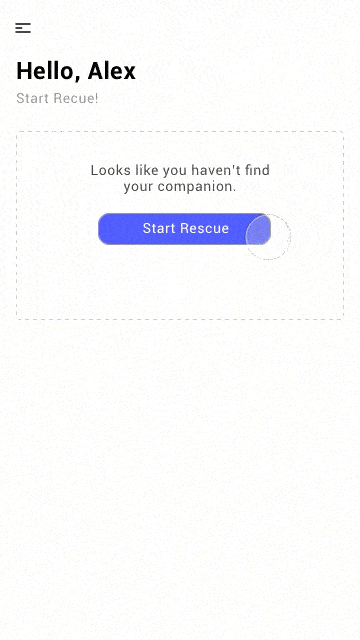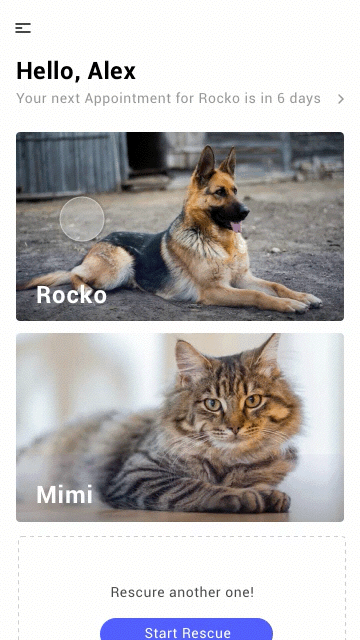
Abby - Pet Adoption.
Design Challenge | 1 weeks | 2018
Millions of animals are currently in shelters and foster homes awaiting adoption. Design an experience that will help connect people looking for a new pet with the right companion for them. Help an adopter find a pet which matches their lifestyle, considering factors including breed, gender, age, temperament, and health status. Provide a high-level flow and supporting wireframes.
Tool Used: Sketch, Illustrator, Invision, Principle, Photoshop, Pen and paper, Human brain
My Role: Personal Project : UX researcher + UX designer + UI designer

01
Design Challenge
Design an experience that will help connect people looking for a new pet with the right companion for them. Help an adopter find a pet which matches their lifestyle, considering factors including breed, gender, age, temperament, and health status. Provide a high-level flow and supporting wireframes.
How to measure the goal?
Reduce the number of pets being returned to the shelter.
How might we create a system to improve energy conservation habits among people?
02
Secondary Research.
I started with defining the challenge, brainstorming assumptions, exploring articles or surveys relative to the topics.
The Main Problems that I found:
One out of ten pets adopted from a shelter was no longer in the home six months later.

Common Reasons why pets are returned
Unexpected costs
Human health issues
Destructive behaviors (for example, soiling in the house, chewing furniture)
Disobedience
Barking
Hyperactivity
Aggression (with children, other family members or pets)
Brown puppy lies on dog bed in dog crate.


03
Competitive Analysis.
I carefully chose AllPaws and WeRescue as the direct competitors. I then applied basic usability, heuristic guidelines to analyze these competitors. Through my analysis, I discovered that none of the apps provide the user full match based on users’ personal traits (likes and dislikes, interests, values, budget etc.) Both the apps become useless after the user chose which pet to adopt. That is also why they are not well-developed.
04
User Interview.
I tried to find pet owners via my personal network. I found both the people who currently have pets and the people who left their old pets. Due to time limitation, I only conducted informal and casual interviews. I want to know how do they decide to get the pet and why do they give them away.

The interview questions mainly focus on their experience with pet adoption, the process, and their frustrations. I also read news articles, message boards and blogs to find out about typical challenges for each phase of the pet adoption process.
The interesting factor I found out is that none of them start looking by downloading a new app. It makes me think why making an app?
INSIGHTS





05
Assumptive Persona.
I decided to create an assumptive persona and her background story in order to better understand and visualize how I could build a solution that satisfies the needs and solves the problems of a specific user group.


06
User Journey.
In order to better understand how a potential solution could help Alex and how it would fit into her life, I mapped out a typical day of adopting a new pet in the shelter.I decided to create an assumptive persona and her background story in order to better understand and visualize how I could build a solution that satisfies the needs and solves the problems of a specific user group.



07
Design Principles.
Combining the insights from the different research sources as well as from the persona, it became clear that the app had to focus on excelling in the following aspects.
At this point I decided to design an app because it need to not only help the user find the perfect match, but also further support the user easily taking a good care of them.
08
Ideation.
Based on the ideas generated in the user journey I started sketching out as many idea as possible. Then two tracks include help the user choose what to see before showing them the pets or show them all the available pets and provide them the ability to filter afterward.


09
User Test.
With some feedback sessions with my friends, I combined the strongest ideas in order to articulate a single idea into a testable prototype. I chose Invision prototype to test out how they feel, find flaws in the logic/flow and generate feedback from other people.

MAIN ITERATION

The main function ”Pet Planning” was iterated a bunch of times.
For the first test, one of the participants mentioned that it doesn’t mean anything besides persuading people into quitting. More accurate cost estimation can help them better planning the budget.
For the second test, the participants struggled with the app's “see recommendations” because there are too many of them. They are getting tired of clicking into another layer. Also, dragging so many sliders is annoying too.

10
Site Map.
With some feedback sessions with my friends, I combined the strongest ideas in order to articulate a single idea into a testable prototype. I chose Invision prototype to test out how they feel, find flaws in the logic/flow and generate feedback from other people.


11
After multiple iterations and many discarded drawings, I had decided on a general direction and moved on to Sketch as it’s easier to make quick adaptations there.
Interaction Flow.



12
Final Interface Design.



Based on research, the energy level and how much attention the pet needs are the most important factors on if they will fit into people’s lives or not. However, people have no idea what does “high energetic” or “medium energetic” means.
The questions “how much time they would be willing to spend every day for their pets” “how many hours they will be away from their new pet” are two alternative ways to ask people. They are based on people’s own lives, hence they are easier to answer.
Also, with the remainder of which kind of pet is rolling out if the user selects shorter time, gives the user a general idea what they would be looking at.
Onboarding
The onboarding starts with a chatbot called Abby that helps you pick the right companion. The main questions asked here are not only helping them match with the ideal pet, but also care about the user's’ own situation that the user would know before looking at the pet adoption page. Also, the micro-interactions give the user the ability to control these details in the app.

Start Rescue
After choosing the pet they like, the user can click on the detailed page to see the basic information about the pet. The order of the information is based on what affects their decisions the most and users' behavior of reading.
The annual cost is estimated based on the type of the pets, the size, and their conditions. It gives the user a general idea if they can afford the pet or not. And why it would cost this much.
Moreover, the user is able to schedule the visit if he/she likes the pet.



Scheduling
Moreover, the user is able to schedule the visit if he/she likes the pet.
Planning
Pet planning is another important feature in the app. It provides the specific recommendation of food choice, medical exams, insurance plan and so on based on the types of the pet. It helps the user quickly learn how to take care of their pets step by step without diving into the internet to search for a long time.



Moreover, the user is able to schedule the visit if he/she likes the pet.

Track Your Own Pet
After the user successfully adopted the pet, the pet will show up on the home page.
The features of tracking and recommendations on how to take care of them (e.g. insurance options, vet information and food choice) can further support the user to better take care of the new pet and not return them.
